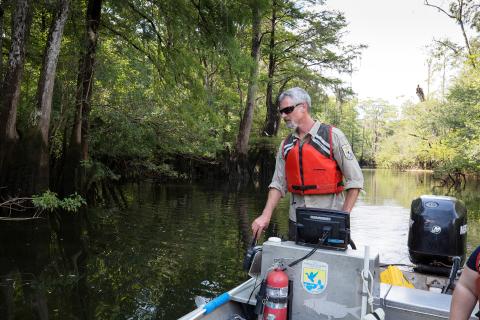The Open Ocean Trustee Implementation Group will implement two monitoring and adaptive management activities to fill critical information gaps to support Gulf sturgeon restoration. The activities are described in two recently-approved implementation plan documents and are aligned with goals we identified in our Monitoring and Adaptive Management Strategy, released in May 2019.
- Informing Gulf Sturgeon Population Status and Trends as a Baseline to Evaluate Restoration (PDF, 9 pg)
- Juvenile Gulf Sturgeon - Gulf-wide Population Dynamics and Habitat Use (PDF, 12 pg)
Gulf sturgeon inhabit coastal waters, rivers and estuaries in the northern Gulf of Mexico from the Pearl River in Louisiana to the Suwannee River in Florida. After spending the first two to three years in the river as hatchlings and juveniles, they spend fall and winter in the Gulf of Mexico and spring and summer in the rivers where they spawn. Up to 3,600 threatened Gulf sturgeon were potentially exposed to Deepwater Horizon oil in the nearshore areas of the northern Gulf of Mexico.
To begin to address these impacts, the Gulf sturgeon project selected in the Open Ocean Restoration Plan 1 will:
- Identify and characterize the potential spawning habitat in the Pearl and Pascagoula River systems.
- Describe habitat accessibility and use during spawning periods, determine river of origin for juvenile sturgeon.
- Synthesize data needed to evaluate and prioritize Gulf sturgeon spawning habitat restoration projects such as in-stream barrier removal, spawning reef creation, or riparian restoration.
Effective restoration for sturgeon requires a better understanding of baseline status and conditions as well. The activities we’re pursuing in these monitoring and adaptive management implementation plans will help us understand Gulf sturgeon populations, and how juveniles utilize estuary habitats. The results of the Restoration Plan 1 sturgeon project and both monitoring and adaptive management activities for sturgeon will help us identify and prioritize habitats regionally most in need of restoration and develop a framework for monitoring the results.
Informing Gulf Sturgeon Population Status and Trends as a Baseline to Evaluate Restoration
There are critical information gaps and uncertainties regarding the abundance and rates of population change of Gulf sturgeon. This activity will address these gaps by developing age-structured population models, an individual-based population viability model, and a database of comprehensive data needed to parameterize the models. It will be implemented over the next four years with an estimated budget of $910,000.
Juvenile Gulf Sturgeon - Gulf-wide Population Dynamics and Habitat Use
Estuaries in the Gulf watersheds where sturgeon live serve as important foraging habitats for juveniles in winter, but little is known about the patterns of habitat use within them. Recruitment, growth, and survival patterns of juvenile Gulf sturgeon are also poorly understood. This activity will address these needs by identifying juvenile habitat use in estuaries and establishing a baseline for juvenile recruitment, growth and survival, and existing and ideal population sizes. This will be implemented over the next four years with an estimated budget of approximately $2 million.
These two monitoring and adaptive management activities are crucial to developing a science-driven, adaptive management framework for Gulf sturgeon restoration. Their successful completion will better inform our ability to plan strategic habitat restoration.


